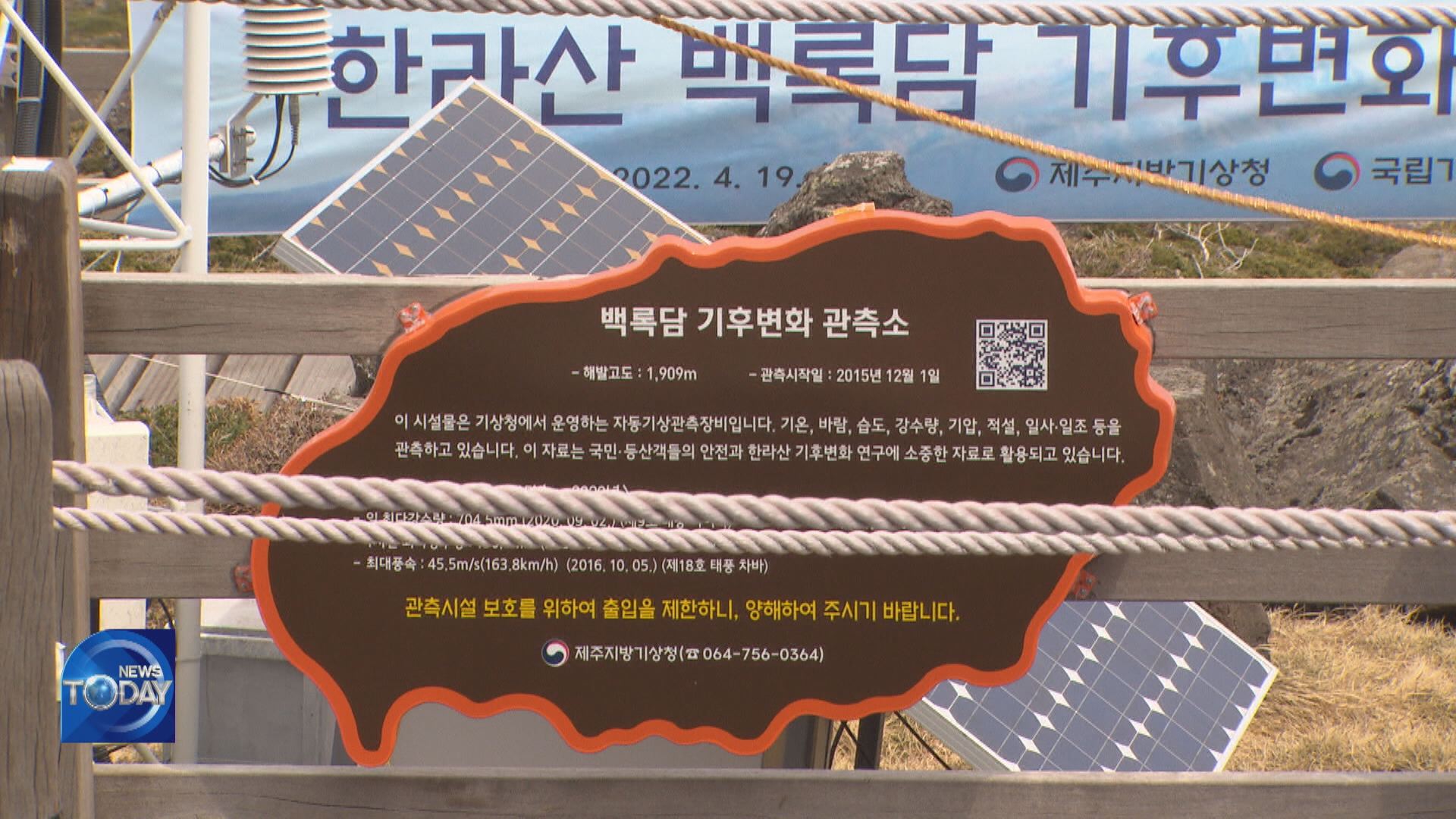CLIMATE OBSERVATORY IN MT. HALLASAN
입력 2022.04.20 (15:21)
수정 2022.04.20 (16:45)
읽어주기 기능은 크롬기반의
브라우저에서만 사용하실 수 있습니다.
[Anchor Lead]
A climate observatory has been installed at the top of Hallasan Mountain on Jejudo Island. Data gathered from Baengnokdam will benefit related research such as changes to the mountain’s vegetation.
[Pkg]
Hallasan Mountain is the tallest peak in South Korea. At 1,705 meters above sea level, some 200 meters to the mountain top, there is a colony of Korean fir trees, an indigenous but endangered species living in the cold highlands. But many of the trees have withered away. The trees have been under threat of typhoons, droughts and climate change since 2012.
[Soundbite] Kim Jong-gab(Curator, Jeju World Heritage Center) : "If temperatures keep rising, the plants will continue to move upwards and the highest limit is 1,950m."
A climate observation station has been established at Baengnokdam crater lake to help with forecasting the constantly changing and unpredictable weather of Hallasan Mountain. The center will observe temperature, precipitation and snowfall near the mountain top area to provide climate data for varying altitudes including down to the coastlines. The Korea Meteorological Administration (KMA) plans to conduct research on Hallasan Mountain’s highland vegetation and its correlation to snowfall and underground water volumes to better respond to climate change.
[Soundbite] Jeon Jae-mok(Director, Jeju Korea Meteorological Administration) : "The station provides crucial climate data related to the habitation of fir trees and broad-leaf bamboo. Weather observations are also possible in connection to the Baengnokdam crater lake’s freshwater and Jeju’s water resources in general."
A weather station at an altitude of 1,909 meters, the highest point in the country, is drawing keen attention as to what critical role it could play in climate change research.
A climate observatory has been installed at the top of Hallasan Mountain on Jejudo Island. Data gathered from Baengnokdam will benefit related research such as changes to the mountain’s vegetation.
[Pkg]
Hallasan Mountain is the tallest peak in South Korea. At 1,705 meters above sea level, some 200 meters to the mountain top, there is a colony of Korean fir trees, an indigenous but endangered species living in the cold highlands. But many of the trees have withered away. The trees have been under threat of typhoons, droughts and climate change since 2012.
[Soundbite] Kim Jong-gab(Curator, Jeju World Heritage Center) : "If temperatures keep rising, the plants will continue to move upwards and the highest limit is 1,950m."
A climate observation station has been established at Baengnokdam crater lake to help with forecasting the constantly changing and unpredictable weather of Hallasan Mountain. The center will observe temperature, precipitation and snowfall near the mountain top area to provide climate data for varying altitudes including down to the coastlines. The Korea Meteorological Administration (KMA) plans to conduct research on Hallasan Mountain’s highland vegetation and its correlation to snowfall and underground water volumes to better respond to climate change.
[Soundbite] Jeon Jae-mok(Director, Jeju Korea Meteorological Administration) : "The station provides crucial climate data related to the habitation of fir trees and broad-leaf bamboo. Weather observations are also possible in connection to the Baengnokdam crater lake’s freshwater and Jeju’s water resources in general."
A weather station at an altitude of 1,909 meters, the highest point in the country, is drawing keen attention as to what critical role it could play in climate change research.
■ 제보하기
▷ 카카오톡 : 'KBS제보' 검색, 채널 추가
▷ 전화 : 02-781-1234, 4444
▷ 이메일 : kbs1234@kbs.co.kr
▷ 유튜브, 네이버, 카카오에서도 KBS뉴스를 구독해주세요!
- CLIMATE OBSERVATORY IN MT. HALLASAN
-
- 입력 2022-04-20 15:21:15
- 수정2022-04-20 16:45:10

[Anchor Lead]
A climate observatory has been installed at the top of Hallasan Mountain on Jejudo Island. Data gathered from Baengnokdam will benefit related research such as changes to the mountain’s vegetation.
[Pkg]
Hallasan Mountain is the tallest peak in South Korea. At 1,705 meters above sea level, some 200 meters to the mountain top, there is a colony of Korean fir trees, an indigenous but endangered species living in the cold highlands. But many of the trees have withered away. The trees have been under threat of typhoons, droughts and climate change since 2012.
[Soundbite] Kim Jong-gab(Curator, Jeju World Heritage Center) : "If temperatures keep rising, the plants will continue to move upwards and the highest limit is 1,950m."
A climate observation station has been established at Baengnokdam crater lake to help with forecasting the constantly changing and unpredictable weather of Hallasan Mountain. The center will observe temperature, precipitation and snowfall near the mountain top area to provide climate data for varying altitudes including down to the coastlines. The Korea Meteorological Administration (KMA) plans to conduct research on Hallasan Mountain’s highland vegetation and its correlation to snowfall and underground water volumes to better respond to climate change.
[Soundbite] Jeon Jae-mok(Director, Jeju Korea Meteorological Administration) : "The station provides crucial climate data related to the habitation of fir trees and broad-leaf bamboo. Weather observations are also possible in connection to the Baengnokdam crater lake’s freshwater and Jeju’s water resources in general."
A weather station at an altitude of 1,909 meters, the highest point in the country, is drawing keen attention as to what critical role it could play in climate change research.
A climate observatory has been installed at the top of Hallasan Mountain on Jejudo Island. Data gathered from Baengnokdam will benefit related research such as changes to the mountain’s vegetation.
[Pkg]
Hallasan Mountain is the tallest peak in South Korea. At 1,705 meters above sea level, some 200 meters to the mountain top, there is a colony of Korean fir trees, an indigenous but endangered species living in the cold highlands. But many of the trees have withered away. The trees have been under threat of typhoons, droughts and climate change since 2012.
[Soundbite] Kim Jong-gab(Curator, Jeju World Heritage Center) : "If temperatures keep rising, the plants will continue to move upwards and the highest limit is 1,950m."
A climate observation station has been established at Baengnokdam crater lake to help with forecasting the constantly changing and unpredictable weather of Hallasan Mountain. The center will observe temperature, precipitation and snowfall near the mountain top area to provide climate data for varying altitudes including down to the coastlines. The Korea Meteorological Administration (KMA) plans to conduct research on Hallasan Mountain’s highland vegetation and its correlation to snowfall and underground water volumes to better respond to climate change.
[Soundbite] Jeon Jae-mok(Director, Jeju Korea Meteorological Administration) : "The station provides crucial climate data related to the habitation of fir trees and broad-leaf bamboo. Weather observations are also possible in connection to the Baengnokdam crater lake’s freshwater and Jeju’s water resources in general."
A weather station at an altitude of 1,909 meters, the highest point in the country, is drawing keen attention as to what critical role it could play in climate change research.
이 기사가 좋으셨다면
-
좋아요
0
-
응원해요
0
-
후속 원해요
0












![[뉴스특보 LIVE] 이재명 대통령, 취임 30일 기자회견](/data/layer/904/2025/07/20250703_dJHo27.jpg)
![[속보] 이 대통령 “3대 특검, 내란 종식·헌법 질서 재건 역할 기대”](/data/layer/904/2025/07/20250703_C7vKPb.png)
![[속보] 내란특검, 김주현 전 민정수석·김성훈 전 경호차장 소환](/data/news/2025/07/03/20250703_jzJu42.jpg)


이 기사에 대한 의견을 남겨주세요.